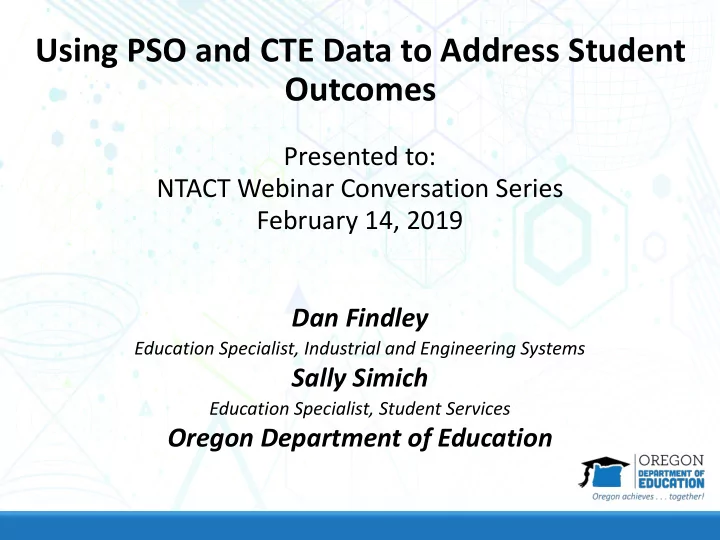

Using PSO and CTE Data to Address Student Outcomes Presented to: NTACT Webinar Conversation Series February 14, 2019 Dan Findley Education Specialist, Industrial and Engineering Systems Sally Simich Education Specialist, Student Services Oregon Department of Education
Agenda I. Overview of Project II. Special Education Student Outcomes III. What is CTE? IV.Special Education & CTE V. Comparison Data Activity VI. Busting the myths
Objective To highlight how Career and Technical • Education can be utilized as a tool to improve outcomes for Students with Disabilities To showcase student stories that provide • anecdotal evidence about how CTE is beneficial for Students with Disabilities
Cross-office Collaboration Partners Oregon Department of Education – Education Programs and Transition team(EPT) Oregon Department of Education - Secondary & Postsecondary Transitions team (SPST) Oregon Department of Human Services - Vocational Rehabilitation
Cross-office Collaboration Mission To improve transition outcomes for youth with disabilities by creating an equitable, sustainable, simplified system, aligned across agencies that reduces redundancy.
Chronology May 2018: NTACT Capacity Building Conference • Redrafting the Oregon Technical Assistance Action Plan • May 2018-Present: ODE analysts collaborate: Career and Technical Education and • Students with Disabilities. The Equity Case • CTE learning and Post School Outcomes (PSOs) • June 2018-Present: Continued data analysis • Co-presentations • Resource development • Late Summer/Fall 2018: Professional Development delivered to CTE Regional Coordinators • throughout Oregon.
Equity • Approach • continuous improvement model with equity as the focus • Framing the conversation • Perkins • The Oregon Equity Lens • NAPE PIPE project
Post-School Outcomes (PSOs) for Students with Disabilities
PSOs for Students with Disabilities • Survey Response Rate • 17 questions Complete No Answer • All Students Exiting 1713, 37% 2935, 63%
PSOs for Students with Disabilities •Enrolled Full- or part-time Higher Education • 2-, 4-, or more year program •One complete term •Worked for pay at or above the Minimum Wage Competitive •In a setting with others who are nondisabled Employment • 20 hours a week •at least 90 days at any time in the year since leaving high school •Enrolled on a full- or part-time basis Other Postsecondary •At least 1 complete term at any time since leaving high school Education or Training •In an education or training program (e.g., adult education, vocational technical school, less than a 2-year program) •Worked for pay or self-employed Other Employment •At least 90 days at any time since leaving high school
PSOs for Students with Disabilities: Engagement (2015-2016) Higher Education 25% 25% Competitve Employment Other Training 8% Other Employment 7% Not Engaged 35%
PSOs for Students with Disabilities: Engagement (2008-2009) 34% Engaged Not Engaged 66%
PSOs for Students with Disabilities: Engagement (2015-2016) 25% Engaged Not Engaged 75%
PSOs for Students with Disabilities The outcomes of Students with Disabilities are improving.
What is CTE?
CTE Defined A sequence of organized educational activities that prepare students for further education and careers…
Program of Study 1. a sequence of courses , 2. aligned to industry standards at the secondary and post- secondary level , 3. that integrates technical and career skill proficiencies with academic content . A CTE POS prepares students for the workplace, further education, training, and community roles. Source: https://www.oregon.gov/ode/learning- options/CTE/resources/Pages/CTEPOS_Applic ation_Resources.aspx
POS: What’s inside?? • Standards and Content • Alignment and Articulation • Accountability and Evaluation • Student Support Services • Professional Development
Definitions • CTE Secondary Participant: • One half (.5) or more credits • Oregon state-approved CTE Program of Study • CTE Secondary Concentrator: • A minimum of 1 credit in CTE courses • at least .5 credit being required • Oregon state-approved CTE Program of Study
Class of 2017 – 4 Year Grad Rate Statewide Graduation Rate: 76.7% (2017)
CTE and Inclusivity 37.87% 50.59% 29.66% 44.66% 16.55% 29.50% 2.90% 7.05% 0% 10% 20% 30% 40% 50% 60% % of Total SPED Population % of Total Population
4-year or 2-year College Attendance (1 year Post-School) CTE Concentrators with Disabilities Non-CTE Concentrators with Disabilties 100.00% 90.00% 80.00% 83.51% 79.86% 78.50% 70.00% 60.00% 60.04% 56.94% 50.00% 52.79% 40.00% 30.00% 20.00% 10.00% 0.00% Class of 2014 Class of 2015 Class of 2016
12 Month Post-School Employment Percentages CTE Concentrators with Disabilities Non-CTE Concentrators with Disabilties 100.00% 90.00% 80.00% 84.04% 80.56% 80.63% 70.00% 68.48% 68.20% 66.47% 60.00% 50.00% 40.00% 30.00% 20.00% 10.00% 0.00% Class of 2014 Class of 2015 Class of 2016
Representation in CTE Differences in Specific Disability Representation Autism Spectrum Specific Learning Disorder Disability Other Health Traumatic Brain Injury Impairments Orthopedic Impairment Emotional Disturbance Communication Disorder Deaf-Blindness Visual Impairment Hearing Impairment Intellectual Disability -10.0% -8.0% -6.0% -4.0% -2.0% 0.0% 2.0% 4.0% 6.0% 8.0% 10.0%
The Importance of Professional Skills
While you were in school, did you learn to? CTE Concentrators Non-CTE with Disabilities Concentrators with Disabilities Make Choices 77% 69% Speak Up 73% 67% Solve Problems 73% 63% Set Goals 72% 62%
Busting Myths Students with disabilities (SWD) can’t succeed in CTE • programs. CTE courses are hazardous! SWDs can’t be trusted to be • safe in a CTE environment. SWDs can’t pass the Technical Skills Assessment (TSA) or • other end-of-program evaluation. CTE is an acceptable place to send students anytime! It’s • not necessary to prepare or train CTE faculty prior to enrolling SWDs.
Next Steps Continued work with NAPE/PIPE • Oregon ACTE • Continued training across the state with counselors as well • as general education and CTE faculty Transition Technical Assistance Facilitators and Youth • Transition Program specialists continue to work together to support faculty and students as SWDs access and achieve in CTE Continued collaboration on the State Plan •
Thank you! Dan Findley, Industrial and Engineering Systems Education Specialist email: daniel.findley@state.or.us phone: 503.947.0338 Sally Simich, Secondary Transition Education Specialist email: sally.simich@state.or.us phone: 503.947.5639
Recommend
More recommend